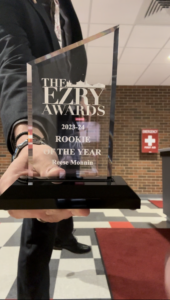On Sunday, Sept. 6, Wittenberg University’s COVID-19 Response Team announced a two-week shift to remote instruction starting Monday, Sept. 7, currently scheduled to last until Sept. 21. Student resources and campus facilities including the CDR, Thomas Library and HPER Center will remain open with their normal schedules during remote instruction.
In the statement, the COVID-19 Response Team cited an “abundance of caution” in their decision, as well as “[ensuring] a more equitable learning model.” The statement also lauded the expanded presence of testing on campus, just days after encouraging asymptomatic students not to get tested in a Friday, Sept. 4 communication announcing a steep rise in cases on campus.
Just hours before the Sept. 4 communiqué, the Wittenberg COVID-19 Response Team announced via the online COVID-19 dashboard that 21 students on campus had tested positive for the coronavirus at the center of the international pandemic, a 2000% increase in cases since Aug. 31. In total, 22 students have tested positive for the virus on campus, representing 1.52% of all cases reported in Clark County.
The Sept. 4 number represented a 50% increase in active cases since Sept. 3, when only 14 cases were active, and a 600% increase since Wednesday, Sep. 2, when just three cases were active. In response, the Wittenberg COVID-19 Response Team introduced a new set of guidelines and expectations on Sept. 3, including an order prohibiting all guests in both residence halls and Witten’Burbs properties and an order restricting travel away from campus except for essential purposes.
The Sept. 4 protocol update by the COVID-19 Response Team also clarified that asymptomatic students are not required to be tested. Students potentially exposed to COVID-19 but not directed by the university contact tracing process or the Clark County Combined Health District are not encouraged to be tested unless they develop symptoms. Neither group is excused from class, approved for remote learning or subject to university quarantine procedures.
The update also announced increased testing hours on campus in the Student Health Center from 1-4 PM, Monday- Friday. The testing is optional, reserved exclusively for symptomatic students.
“Initially, the plan was to contain the virus from coming onto campus from the community, and now the opposite is in effect.”
Charles Patterson, Clark County Combined Health District
Of the ten colleges in the North Coast Athletic Conference, Wittenberg is the only member institution that did not require testing of any kind before or upon move-in. Allegheny, DePauw and Wabash each required tests before students came to campus at all. Denison, Hiram, Kenyon, Oberlin, Ohio Wesleyan and Wooster all tested students as they arrived on campus and implemented mandatory quarantine until tests were returned. Oberlin, Ohio Wesleyan, Allegheny and Wabash will continue to randomly test students on campus through at least November.
As of Sept. 4, Kenyon and Wooster currently had zero active cases, while Allegheny, DePauw, Hiram and Oberlin had less than ten active cases. Ohio Wesleyan has a confirmed total of 27 cases but had just 14 students remaining in isolation as of Aug. 28.
Wittenberg President Mike Frandsen defended the university’s decision not to mandatorily test students.
“That was the advice that we received from the CCCHD and from the medical professionals who were working with us,” Frandsen said. “We considered all sorts of different testing options and reviewed scientific literature on different testing. The challenge with testing is it’s a point in time. And you and I could get tested right now, and not show symptoms, not show positive test, but be contagious. And so, if you can’t do a testing regimen, it’s not particularly effective; at least, that’s what we’re hearing from the [Clark County Combined] Health District and the medical professionals.”
Health Commissioner Charles Patterson of the CCCHD, with which Wittenberg cooperated to develop its early COVID-19 protocol, seemed to be in favor of more testing than Frandsen. “We support testing of symptomatic persons as well as those who are direct contacts of confirmed cases,” Patterson said. “Immediate testing of contacts is discouraged due to the incubation period of the COVID-19 virus. A negative test does not allow for a shorter quarantine period if the individual is a close contact of a confirmed case.”
Frandsen also suggested that the CCCHD was concerned about Clark County’s testing capacity.
“In Clark County, there’s still a concern about capacity of [available] tests for those who really need them,” Frandsen said. “The advice we got as recently as [Friday] morning from the Health District is that symptomatic testing is what we should be pursuing and what the system can really support right now.”
The COVID-19 Response Team’s protocol update seemed to corroborate Frandsen’s concern. “Asymptomatic students are highly encouraged NOT to test for COVID-19 until directed by a medical professional or a contact tracer,” the update said. “In most cases, these produce false negatives that misrepresent your health situation and will create unnecessary backlogs to the lab that will slow down return times.”
Patterson contrasted Frandsen’s characterization of Clark County’s testing capacity. “There are plenty of tests available in Clark County,” he said. “The problem is the limited hours when tests are available here.” His greater concern was Wittenberg’s lack of resources as it begins expanded testing regiments. “Random asymptomatic testing off campus is not discouraged but it could tax the on-campus testing system,” he said.
The Harvard Medical School’s COVID-19 research team’s conclusion opposes Wittenberg’s COVID-19 Response Team characterization of the incubation period. An Aug. 25 article on the team’s Harvard Health Publishing website stated that COVID-19’s incubation period, the time between infection and the appearance of symptoms, may be as little as three days, with symptoms usually appearing four to five days after infection. The research team also reported that people may become contagious as many as 48 hours before symptoms begin.
As cases continued to rise on campus, President Frandsen characterized Wittenberg’s potential threat to the community as “minor.” Patterson expressed more concern. “Wittenberg’s current outbreak presents an added strain to the ongoing pandemic,” he said. “Initially, the plan was to contain the virus from coming onto campus from the community, and now the opposite is in effect.”
Kenyon College, with zero active cases, has limited campus to freshmen and sophomores for the fall semester. Since move-in began on Aug. 22, the college has conducted at least 2,247 tests of students and faculty. The college developed its own COVID-19 protocol in collaboration with the Knox County Health Department, a county with less than half of the residents of Clark County and 83% fewer COVID-19 cases.
Kenyon’s protocol skirted scarce COVID-19 resources by outsourcing testing to Everlywell, an Austin, TX-based home test producer that charges $109 for a 72-hour COVID-19 test. For the limited on-campus testing that it does, Wittenberg partners with the Cincinnati-based Mercy Health system, which runs all on-campus student health facilities.
Despite the recent spike in cases and shifts in tactics on the part of the university, both Frandsen and Patterson praised the Wittenberg team’s rapid response and dedication to student safety.
“The University and it’s [sic] COVID-19 Response Team has worked tirelessly to have a fantastic, flexible plan and is now implementing the same,” Patterson said. “We have not experienced any team in our community that has worked harder or more often to prepare for the pandemic than Witt’s COVID-19 Response Team. We are truly blessed to work with a team who has the health of the entire Wittenberg community in mind and has strived to be able to reopen campus this fall.”
And despite his praise of the COVID-19 Response Team, Patterson indicated that more moderate measures by the university may not be sufficient to stop the outbreak. “We need the entire student body to band together to keep school in session and also protect the faculty, staff and greater community. It is time to discuss a reset to get this under control.”
Frandsen also expressed a rare frustration with students who are not following university protocols. “We still have people who are not wearing masks when they should be and who are not distancing when they should be,” he said. “But we all have a role to play here, right? Students have a role to play. Faculty have a role to play. Administrators have a role to play… the majority of the members of the community are doing what they need to do. But there is a minority who are not, and they are putting all of us at risk… They owe it to all of us to be concerned. And if they’re not concerned about their own health or the health of others on campus…. maybe they should go home. But this is real. This is real. And people should absolutely be concerned about it.”
Read the Torch’s full conversation with President Frandsen here.








1 thought on “Wittenberg Temporarily Moves Classes Online as Cases Rise”